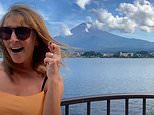
Travel writer Jo Kessel filmed her climb up Japan’s highest and most sacred mountain. The footage shows how exhaustion, doubt and the odd stumble creep in during what’s a lung-busting, relentless uphill ascent through and above the clouds. Plus, the video gives the inside scoop on where to stay and how to recover afterwards, including a saucy soak in a Japanese ‘onsen’ (hot spring) where it’s obligatory to bathe naked.
‘Anyone can do it!” said a friend when I mentioned I was thinking of climbing Mount Fuji.
I’ve no idea why they thought this was the case seeing as they’d never climbed it themselves, but it was all the encouragement I needed to decide to sign up.
A few weeks later saw me heading to Japan’s capital Tokyo, which is only 62 miles (100km) away from the mountain. From here one of the country’s famous bullet trains delivered me to Fuji at 186mph (299kph).
At 3,776m (12,388ft) Mount Fuji is Japan’s highest mountain and its iconic flat-topped cone shape has made it one of the most photographed peaks in the world.
Travel writer Jo Kessel (pictured) films her climb up Mount Fuji, Japan’s highest and most sacred mountain
Jo says that Mount Fuji’s ‘iconic flat-topped cone shape has made it one of the most photographed peaks in the world’
The Japanese call it ‘Fujisan’ and it’s thought to bring good luck, which is a curiosity seeing as the mountain is actually a giant volcano! It last erupted in 1708 and, while still active, it comes with a very low risk of eruption.
Mount Fuji stands alone and is visible from bottom to tip, soaring dramatically from the earth. Its summit is piercing the sky when I first glimpse it, ringed by a ruff of clouds. It’s so disconcertingly sheer and high that doubts start creeping in about being able to make it to the top. Whatever happens I’m hoping to capture the whole escapade on camera – sweat, exhaustion, stumbles and all.
There are four trails up Mount Fuji and the video begins at 4am on the Yoshida Trail, thought to be the easiest route. Why start at the crack of dawn?
Because the average climbing time from here is six hours up, four hours down and, if you want to do it in one day, it’s best to begin early.
Jo begins her ascent of the mountain with guide Etsuko (pictured left in image two) on the Yoshida Trail, thought to be the easiest route
In any event it’s a bonus to catch the sunrise. It blushes the ashen volcanic landscape a fiery red – a reminder of why Japan is called the Land of the Rising Sun.
It’s possible to climb Mount Fuji independently, but I’ve booked a private guide for peace of mind and to prevent getting lost. Her name’s Etsuko and, as we do some pre-hike stretching, she mentions that she’s climbed this mountain an astonishing 700 times!
It’s clear from the get-go that the ascent will require a slow, steady pace as the trail winds uphill.
The climb is punctuated by ‘stations’ where mountain huts offer refreshments and shelter – we started at the fifth station and the summit sits at the tenth. Vegetation disappears the higher we climb and the constant uphill slog warms us up to the point that we start stripping off layers.
Terrain becomes rockier and more challenging and walking poles are helpful.
Around two hours into the hike, the video sees me reach a mountain hut where a gentleman called Hiro (he’s a bit of a YouTube sensation) serves a special brew of mountain chai. It’s not cheap.
A Barbie-size cup costs 500 yen (nearly £3!) but it’s worth every cent. It’s hot, sweet and delicious and helps recharge tiring legs.
Jo finds that further up, the terrain becomes rockier and more challenging
If climbing Fuji in one day sounds too daunting, the alternative is to overnight in a mountain hut like the one featured next – be warned there’s limited availability and they’re pricey to stay in.
Like the chai, everything up the mountain comes with an eye-watering price tag. Think $5 (£4) for a 500ml bottle of water!
So I’ve come with a backpack full of goodies and tuck into a picnic breakfast.
Fuelling up is essential to prepare for the steeper, rockier trail ahead. While huffing, puffing and putting one foot mindlessly in front of the other I remember my friend’s thoughts on climbing Mount Fuji: ‘Anyone can do it!’
Jo orders a special brew of mountain chai. ‘It’s hot, sweet and delicious and helps recharge tiring legs,’ she says
If climbing Fuji in one day sounds too daunting, the alternative is to overnight in a mountain hut (above), Jo reveals
The footage shows me questioning this claim and captures audio of my laboured, lung-busting breaths. Truth is that I’m not convinced ‘anyone’ can climb Mount Fuji.
You don’t need to be an athlete, but it does require a decent level of fitness and endurance.
The magnificent views above the clouds, however, are great at keeping you going… and going.
‘The footage captures the euphoria when I reach the summit (three images above) after several challenging, gruelling and exhausting hours,’ writes Jo
Jo notes that the descent, which takes around four hours, is ‘hard on the knees’
The pace slows as the air thins and, just as I’m starting to seriously flag, Etsuko points out a Shinto mountainside shrine. She shows me how to pray and somehow this helps me summon the energy and courage for the final push.
The footage captures the euphoria when I reach the summit after several challenging, gruelling and exhausting hours. No matter the trembling muscles and aching legs – we’re above the clouds and it feels like being on the top of the world.
Of course, what goes up must come down and the descent is hard on the knees. The terrain is slippery and the footage captures a scary moment where I stumble, skid and slide.
After hiking Mount Fuji, Jo returned to her room at the nearby Hotel Tominoko (above). ‘It’s a great spot to flop post-hike and to allow limbs to recover,’ she says
Jo takes in the view of Tokyo from the city’s skyscraper Park Hotel, where she stayed for a couple of nights
TRAVEL FACTS
A private guided hike up Mount Fuji and two nights’ half board accommodation at the Tominoko Hotel, Kawaguchiko, costs from £925 based on two people sharing. HIS is an international travel agency that specialises in travel across Japan. Visit www.his-euro.co.uk or call +44(0)2074843333.
Double Rooms at the Park Hotel Tokyo (www.parkhoteltokyo.com) cost from £270.
The film ends by looking at accommodation, from the skyscraper Park Hotel in Tokyo (where I stayed a couple of nights after arriving in Japan) to Hotel Tominoko, near Mount Fuji. The Tominoko is in the lakeside town of Kawaguchiko and my room’s balcony has a superb lake and Mount Fuji view. It’s a great spot to flop post-hike and to allow limbs to recover. The hotel has a natural hot spring Japanese bath (called an ‘onsen’) and the liquid heat is a balm for aching limbs. Be warned: it’s a cultural tradition to bathe naked in onsen, whether they’re single-sex or mixed. By a stroke of luck I have the bath to myself so, while it’s weird to be soaking in it starkers, it’s less embarrassing than it could have been!
Climbing Mount Fuji was one of the most challenging physical feats I’ve experienced and feels like a great achievement. I was accompanied by my teenage son (he operated the camera) and even though he’s young and fit he still found it tough-going. Listen out for his heavy breathing as he films my closing piece to camera!
It took less than six hours of actual climbing time to reach the summit (we stopped a lot to film and take photos) and four hours to get back down. Pleased I did it? Absolutely! Do it again? Probably not!
For more videos from Jo, visit her YouTube channel, Go With Jo. Ishikari Lore by Kevin MacLeod is licensed under Creative Commons Attribution 4.0.
MOUNT FUJI BY THE NUMBERS Mount Fuji is Japan’s tallest mountain at 3,376m (12,400 feet).Around 300,000 people attempt to climb it every year.There are four different trails that lead to its summit.It takes on average six hours to climb up, four hours to descend.The official climbing season runs for only two months, from early July to mid-September.Mount Fuji is only 62 miles (100km) from Japan’s capital, Tokyo.Mount Fuji is actually part of three volcanoes, one on top of the other. The bottom layer is Komitake volcano, the second one is Kofuji, while Fuji sits on the top.It last erupted in 1708.
Source link
CHECK OUT: Top Travel Destinations
READ MORE: Travel News



